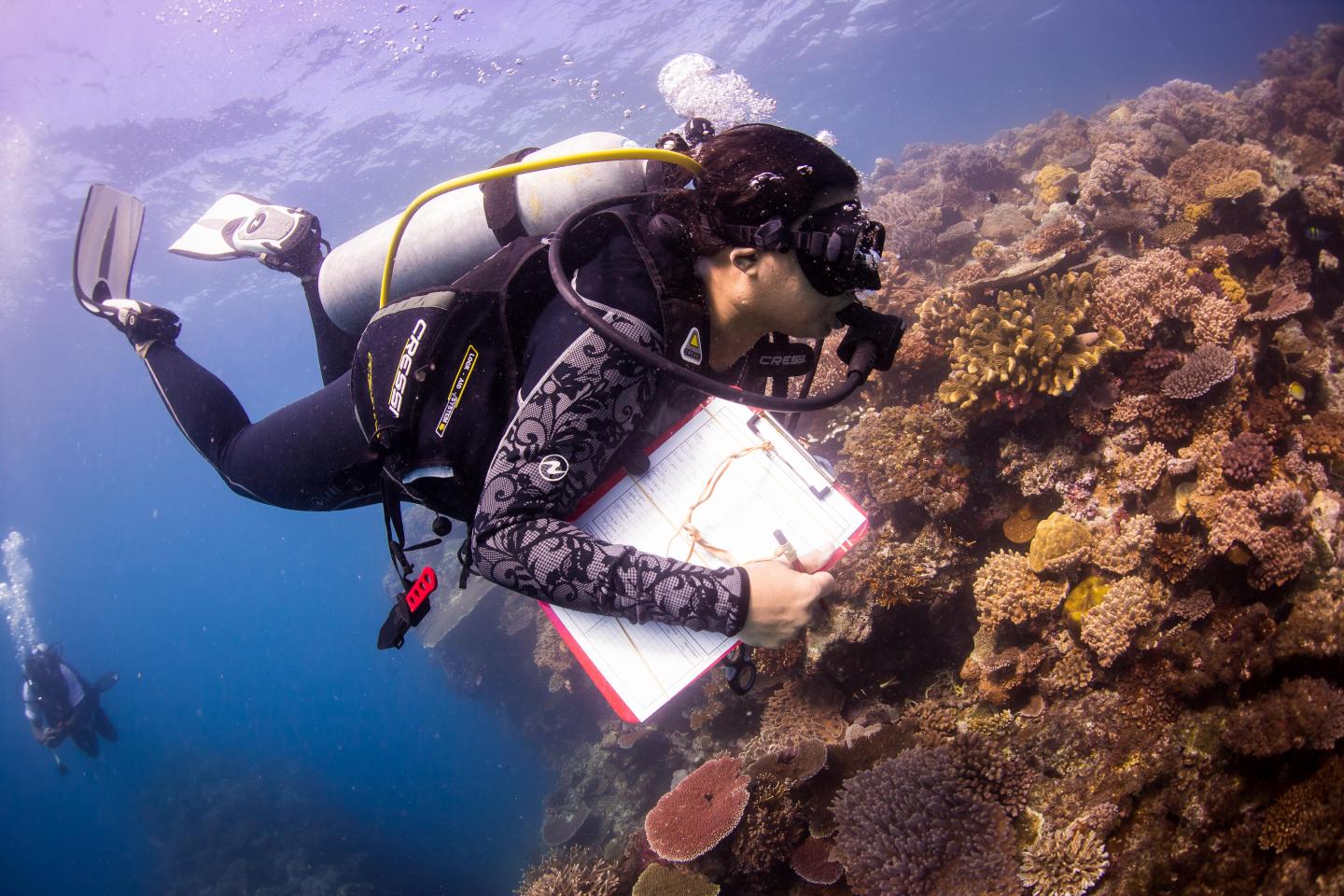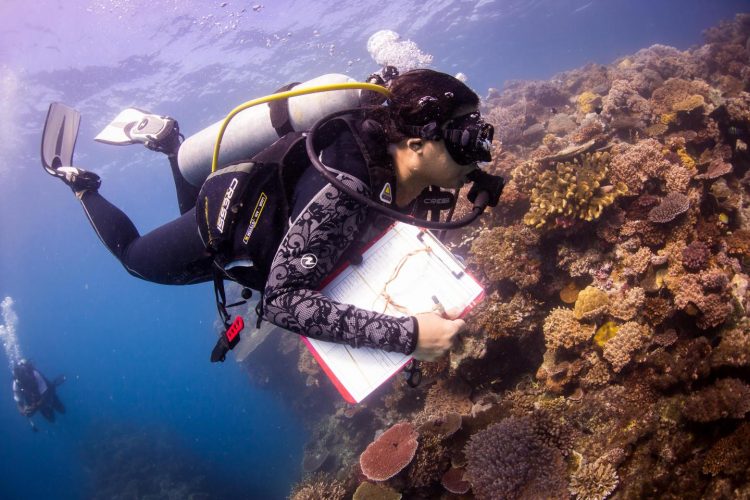Study in Nature Climate Change analyzed many factors that led to widespread coral bleaching in Indo-Pacific during 2016 El Niño

Credit: Emily Darling/WCS.
As conservationists grapple with unprecedented levels of coral reef bleaching in the world’s warming oceans, scientists in the Indian and Pacific Oceans used the most recent El Niño of 2016 (the warmest year on record) to evaluate the role of excess heat as the leading driver of coral bleaching.
The findings were, in a word, complicated, according to marine researchers from WCS (Wildlife Conservation Society) and other groups. Specifically, the WCS-led study revealed a more complex view than current standard predictions of coral bleaching events caused primarily by heat stress; rather, the scientists found that bleaching is driven by a variety of stressors, and each region responds differently.
The authors note that any good predictions of the future will need to consider these complexities, specifically because they are important for effective policies, management, and conservation plans.
The new study titled “Temperature patterns and mechanisms influencing coral bleaching during the 2016 El Niño” appears in the latest edition of Nature Climate Change.
“Our results suggest that coral responses to global climate change may be changing as corals have different past experiences and tolerances to heat and stress,” said Dr. Tim McClanahan, WCS Senior Conservation Zoologist and co-author of the study. “The consequence is that management and policies need to be aligned with the locations and types of stresses if we are to identify potential refugia and other priority actions for coral reefs.”
The widespread coral bleaching in the Indo-Pacific during the most recent El Niño event (2014-2017) was the latest in a series of thermal stresses to impact corals in the region, preceded by events in 1983, 1988, 1998, 2005, 2010, and 2013. The year 2016 brought about the most severe bleaching episodes, including extensive mortality in the Great Barrier Reef.
Coral communities are symbiotic relationships between animals (corals) and algae that give their hosts color and sustenance. According to previous studies and field observations, coral bleaching generally occurs when corals expel their algae while under stress from water temperatures significantly above normal. Reefs closer to the warmer equator have also bleached more in the past and expected to degrade further in 2016.
But assessments made from the field during the study–with data collected from 226 sites stretching from East Africa to Fiji–found that coral bleaching patterns did not neatly align with past predictors of excess temperature and distance from the equator. Instead, bleached corals were highly variable in terms of warm water temperatures and location, with some reefs suffering bleaching levels of up to 60 percent and others surviving with no impact.
To determine what other mechanisms are at work in coral bleaching events, the scientists evaluated 26 variables and more than 2000 models that were solved by a supercomputer to test the effects of factors such as thermal exposure, depth, habitat, coral community composition, and the types of management used in reef systems.
In terms of geography, the researchers found that bleaching depended greatly on where the corals lived along the longitudinal gradient from East Africa to Fiji, with the strongest bleaching observed in East Africa. Consequently, some regions, it seems, will be affected earliest and worse than other regions.
Examining seawater temperatures 90 days before the bleaching, the researchers found that the best predictors of coral bleaching were highest average temperatures, how long cool water endured prior to peak temperatures, and the existence of two peaks in temperature. However, this depended on where the reefs were located, and East African reefs were found to be more stressed than reefs in Indonesia and Fiji. Thus, it was general stress rather than just warm water that affected corals the most, and some coral locations responded to stress better than others did.
###
The authors of the study are: Tim R. McClanahan; Emily S. Darling; Joseph M. Maina; Nyawira A. Muthiga; Stéphanie D’agata; Stacy D. Jupiter; Rohan Arthur; Shaun K. Wilson; Sangeeta Mangubhai; Yashika Nand; Ali M. Ussi; Austin T. Humphries; Vardhan J. Patankar; Mireille M.M. Guillaume; Sally A. Keith; George Shedrawi; Pagu Julius; Gabriel Grimsditch; January Ndagala; and Julien Leblond.
WCS’s work on this study was made possible by the John D. and Catherine T. MacArthur Foundation, the Sustainable Poverty Alleviation from Coastal Ecosystem Services, the Waitt Foundation, The Tiffany & Co. Foundation, and Margaret A. Cargill Philanthropies.
Wildlife Conservation Society (WCS)
MISSION: WCS saves wildlife and wild places worldwide through science, conservation action, education, and inspiring people to value nature. To achieve our mission, WCS, based at the Bronx Zoo, harnesses the power of its Global Conservation Program in nearly 60 nations and in all the world’s oceans and its five wildlife parks in New York City, visited by 4 million people annually. WCS combines its expertise in the field, zoos, and aquarium to achieve its conservation mission. Visit: newsroom.wcs.org. Follow: @WCSNewsroom. For more information: +1 (347) 840-1242.
About Bloomberg Philanthropies’ Vibrant Oceans Initiative:
As climate change increasingly threatens key ocean ecosystems, Bloomberg Philanthropies’ Vibrant Oceans Initiative is working around the world to advance evidence-based conservation practices and implement data-driven policies to protect our oceans and the 3 billion people that depend on them. Launched in 2014, Bloomberg’s Vibrant Oceans Initiative currently operates with partners Rare, Oceana, Global Fishing Watch, and the Wildlife Conservation Society in 10 countries that are top fishing nations – Australia, the Bahamas, Chile, Fiji, French Polynesia, Indonesia, the Philippines, Tanzania, Peru and the United States – to win science-based policies, protect priority coral reefs least vulnerable to climate change, and increase transparency through the adoption of national fishing data platforms.
The John D. and Catherine T. MacArthur Foundation supports creative people, effective institutions, and influential networks building a more just, verdant, and peaceful world. MacArthur is placing a few big bets that truly significant progress is possible on some of the world’s most pressing social challenges, including over-incarceration, global climate change, nuclear risk, and significantly increasing capital for the social sector. In addition to the MacArthur Fellows Program, the Foundation continues its historic commitments to the role of journalism in a responsible and responsive democracy; the strength and vitality of our headquarters city, Chicago; and generating new knowledge about critical issues.
Media Contact
John Delaney
[email protected]
Original Source
https:/
Related Journal Article
http://dx.





